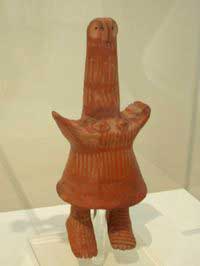.
Daidala is a Greek festival of reconciliation that was held every four (seven?) years in honor of Hera at Plataea in Boeotia. Every fourteen cycles a Great Daidala was celebrated all over Boeotia. In the great festival, a wooden statue, referred to as a daidala, was led in procession in a wagon and then burned in a fire. This archaic custom was explained with a myth (an aition or "origin myth") about Hera and Zeus, which is related by Pausanias:
"Hera, they say, was for some reason or other angry with Zeus, and had retreated to Euboia. Zeus, failing to make her change her mind, visited Kithaeron, at that time despot in Plataea, who surpassed all men for his cleverness. So he ordered Zeus to make an image of wood, and to carry it, wrapped up, in a bullock wagon, and to say that he was celebrating his marriage with Plataia, the daughter of Asopos. So Zeus followed the advice of Kithairon. Hera heard the news at once, and at once appeared on the scene. But when she came near the wagon and tore away the dress from the image, she was pleased at the deceit, on finding it a wooden image and not a bride, and was reconciled to Zeus. To commemorate this reconciliation they celebrate a festival called Daidala, because the men of old time gave the name of daidala to wooden images... the Plataeans [of Plataia, Boiotia] hold the festival of the Daidala every six years, according to the local guide, but really at a shorter interval. I wanted very much to calculate exactly the interval between one Daedala and the next, but I was unable to do so. In this way they celebrate the feast."
- Pausanias (9.3.1-3)

An archaic ceramic daidala of Athena Glaukopis ("owl-faced" Athena), used as the mascot for the 2004 Olympic Games. The image's phallic head is not unique, but passed without comment during the Games. (National Archaeological Museum, Athens)
In a variant of the origin myth Zeus was advised by a hero named Alalkomeneus.
The cult of Hera in Plataea was one of the major cults of the city. The Daidala at Plataea was celebrated every four years. At the Daidala the Plataeans went to a sacred oak grove and by divination chose an oak to be carved into a statue, to which they gave the name Daidala, with the connotation that it was crafted or fashioned (compare "Daedalus").
After fourteen four-year cycles, the Great Daidala festival was celebrated, which drew together a number of cities in a reconciliation celebration of great importance. At the start of the Great Daidala one wooden figure was chosen from the many that had accumulated and designated the bride. The wooden idol was prepared as a bride for a wedding, first with a ritual bath in the River Asopus. Next the wooden bride was dressed, set in a wagon with an attendant. The wagon led a procession up to Mount Kithairon with the participants singing an epithalamion.
At the mountaintop there was an altar and a pyre, where for each community a cow was sacrificed for Hera and a bull for Zeus. The wooden bride was also placed on the altar, and all was immolated in a magnificent hecatomb.
References
- Sue Blundell and Margaret Williamson, The Sacred and the Feminine in Ancient Greece, 1998
| Ancient Greece
Science, Technology , Medicine , Warfare, , Biographies , Life , Cities/Places/Maps , Arts , Literature , Philosophy ,Olympics, Mythology , History , Images Medieval Greece / Byzantine Empire Science, Technology, Arts, , Warfare , Literature, Biographies, Icons, History Modern Greece Cities, Islands, Regions, Fauna/Flora ,Biographies , History , Warfare, Science/Technology, Literature, Music , Arts , Film/Actors , Sport , Fashion --- |
Retrieved from "http://en.wikipedia.org/"
All text is available under the terms of the GNU Free Documentation License

